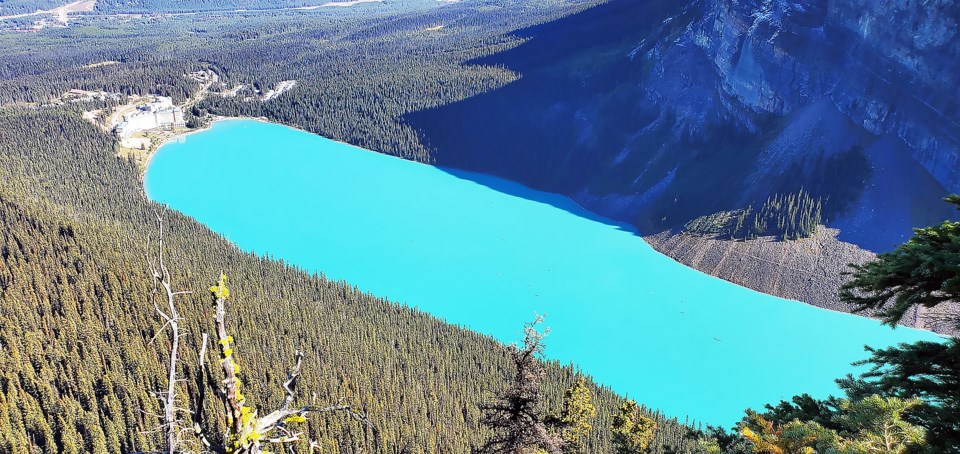LAKE LOUISE – Lake Louise Drive will undergo a $9.8 million redesign in a bid to improve the experience for millions of visitors travelling to the iconic turquoise lake and to help threatened grizzly bears and other wildlife travel safely throughout the busy area.
The federal government announced on Jan. 23 approximately $71 million over three years for projects in the mountain national parks, including $9.8 million for a redesign of Lake Louise Drive to accommodate transit infrastructure, private vehicles and cyclists.
One of the goals is to improve summer traffic flow and reduce traffic jams, which can cause vehicles to back up all the way to the Trans-Canada Highway, making it difficult for emergency services to access the area, causing frustration for visitors and residents alike, and forming a barrier for wildlife.
Parks Canada officials say the redesign will include intersection improvements and could also include either a designated bike path on the existing road or a separate trail, depending on recommendations and reviews from wildlife biologists and traffic engineers.
François Masse, superintendent for Lake Louise, Yoho and Kootenay field unit, said Lake Louise Drive sees more than one million vehicles a year, noting new traffic control measures and road design for a variety of transportation options will provide safer access and improved visitor experience.
“Two key ways to access the site that are becoming more and more important – public transit and active transportation – so we want to make sure as we do that redesign work that it’s going to be easy and efficient for the shuttles and also have a good way for people to get up there on bicycles,” he said.
The work falls out of the draft Lake Louise Area Strategy and Banff National Park Management Plan, which call for a sustainable transit system to help improve visitor experiences as well as maintaining low traffic volumes on Lake Louise Drive during sensitive periods to allow for wildlife movement.
Lake Louise Drive, which has seen a 71 per cent increase in traffic volume over the past decade, cuts through the Fairview wildlife corridor. It is one of two critical wildlife corridors in Lake Louise used by wildlife to travel between areas to reproduce, feed and find shelter.
These corridors provide important movement pathways for wary wildlife in an area otherwise constrained by development and steep mountain terrain. They also provide core habitat for resident animals that may not travel far beyond the area.
In addition, the Lake Louise area is also part of a core reproductive range for grizzly bears, which are a threatened species in Alberta.
Growing traffic congestion, together with illegal parking along road shoulders, forms a barrier to wildlife movement across the road.
Masse said the design for Lake Louise Drive will include methods of improving habitat connectivity to allow for the safe movement of wildlife.
“We want to make sure that we’re actually improving how wildlife can cross that area,” he said.
“We’re definitely looking at crossing structures, but we’re also looking at other measures that can help.”
This year, Parks Canada is banning private vehicles to Moraine Lake, making it mandatory to take Parks Canada-run shuttles from a park-and-ride lot at the Lake Louise ski hill, Roam public transit, or commercial buses. Guests of Moraine Lake Lodge and individuals in vehicles displaying proper accessibility hang-tags will be permitted to travel by private vehicle.
While there is no plan to eliminate private vehicles on Lake Louise Drive to Upper Lake Louise at this time, it is not off the table as an option in the future.
The Parks Canada-struck expert panel on moving people sustainably in Banff National Park recommended banning private vehicles to Upper Lake Louise, combined with a robust transit system.
Masse said Parks Canada will be mindful to make the design of Lake Louise Drive “future-proof.”
“The future of Lake Louise can go a number of ways. As traffic increases we might have to adjust the approach, but right now we are not planning any changes to how people access Upper Lake Louise for next summer,” he said.
“But we’re going to be doing assessments and we’re keeping a very close eye on the carrying capacity of that site, and keeping that in mind, as we work on Lake Louise Drive, we want to make sure that the design is going to work under a variety of future potential scenarios.”
Masse said traffic engineers will work on the preliminary design, which should be out for public review and comment in spring or early summer. The project will also undergo an environmental assessment.
“I am expecting we’ll see a little bit of preliminary work somewhere in the summer of 2023, so we’re expecting a little bit of traffic management around that this summer, but the bulk of the work is most likely going to be in the summer of 2024,” Masse said.
As part of the $71 million federal funding investment announced this week, there are several road paving projects in Yoho, Kootenay, Banff and Jasper national parks.
In addition, $12.1 million will be spent on ongoing repairs and upgrades to water and sewer infrastructure in Lake Louise.
Another $1 million will go towards upgrading aging dispatch equipment at Banff and Jasper dispatch centres.
“Improvements to Parks Canada’s first response capabilities with dispatch equipment upgrades will maintain quick and effective response times in dangerous situations,” said Terry Duguid, who is the parliamentary secretary to the federal minister of environment and climate change in a news release.




